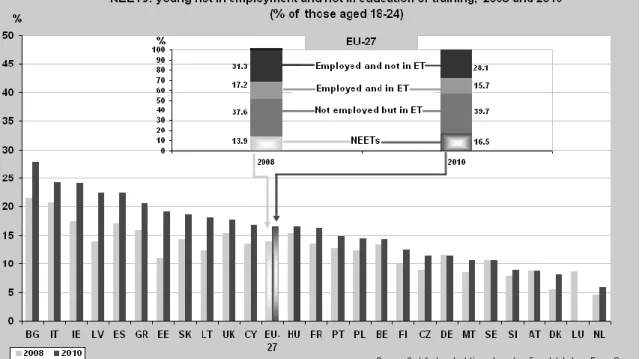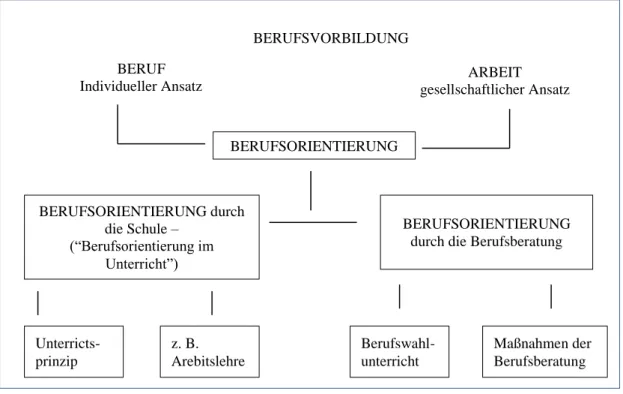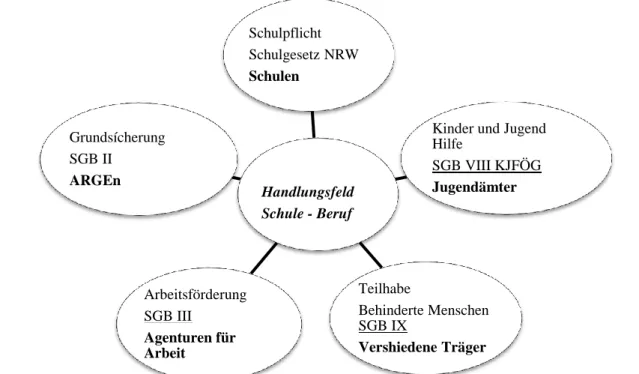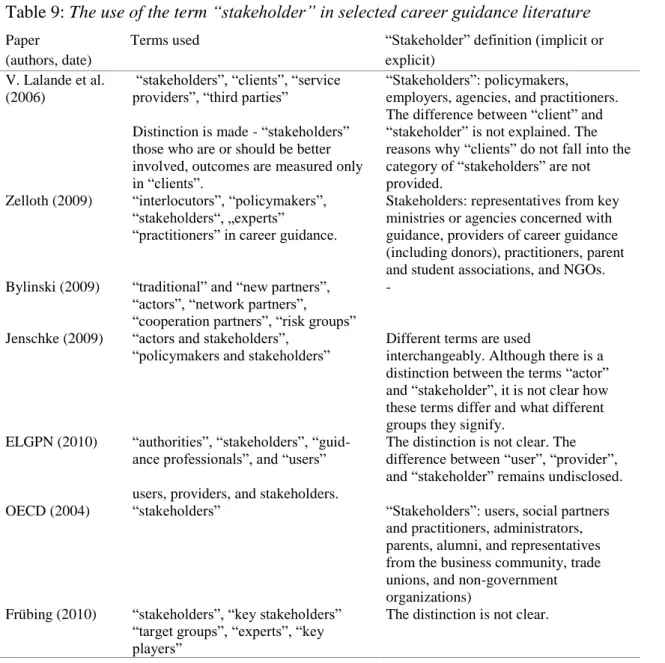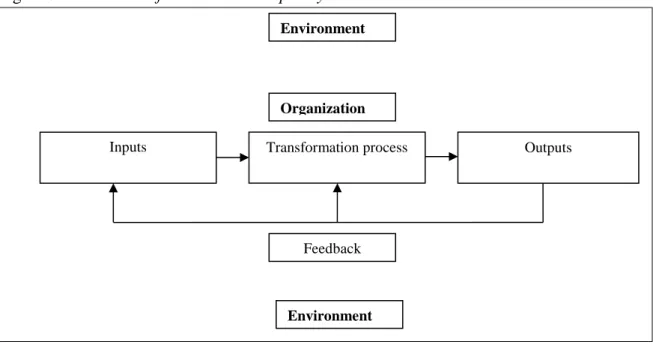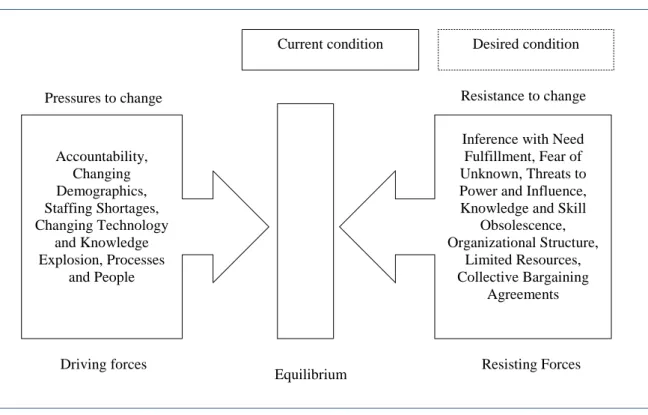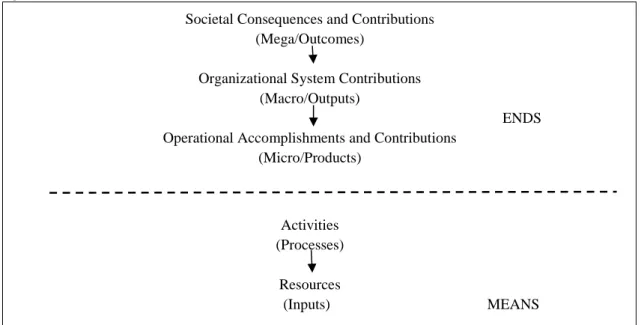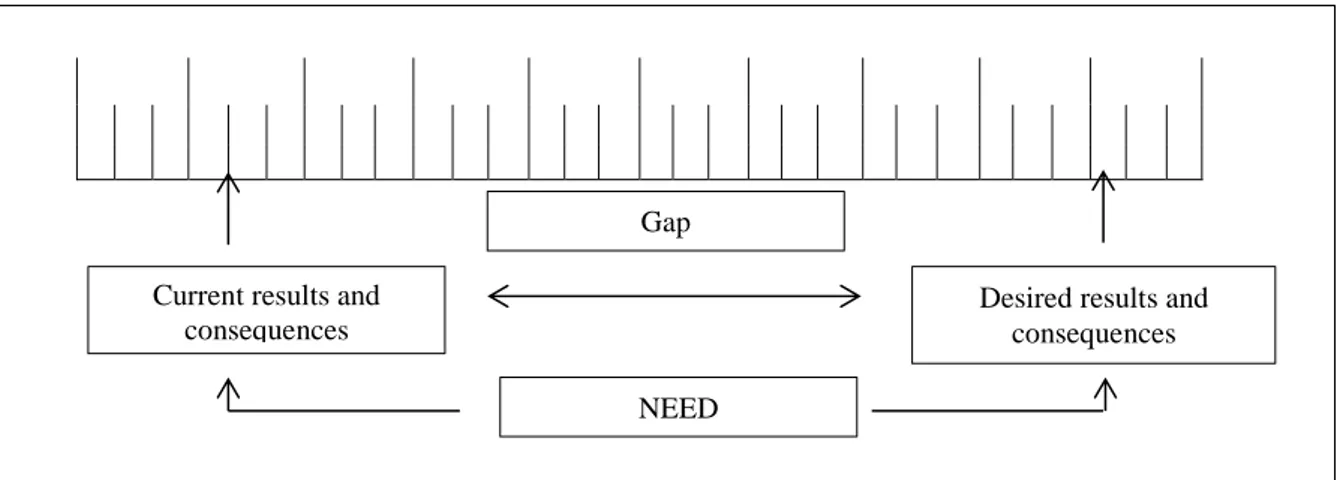Systemic and Strategic Development of School-based Career Guidance from the Perspectives of Stakeholders
A normative collective case study conducted in the German Land of NRW
by Jolanta Kavale
A Thesis Submitted to the Faculty of Erziehungswissenschaft und Soziologie
Technische Universität Dortmund in Fulfilment of the Requirement for the Degree of Doctor Philosophy (Dr. phil.)
of Sociology and Education
North Rhine-Westphalia, Dortmund, 2012
Declaration of Authenticity
I declare that this thesis contains no material which has been accepted for the award of any other degree or diploma in any university or other institution. To the best of my knowledge and belief, this thesis contains no material previously published or written by another person, except where due reference is made in the text.
Signature Jolanta Kavale Date 12 10 2012
Acknowledgements
I would like to express my sincere appreciation to my thesis supervisors –Prof. Wilfried Bos, Prof. Josef Keuffer, and Prof. Hans-Uwe Otto who provided support during my entire three years doctoral program. A great push forward and opportunity to get acquainted with specific problems of school-work transitions and career guidance in Germany was provided from the beginning of my studies through doctoral students’
colloquiums and round table discussions organized by Prof. Keuffer.
I have been greatly inspired by and have learned from Prof. Bos’s achievements in supervising and constantly delivering large-scale education and school development projects with the greatest professional responsibility. As my thesis first supervisor, Prof.
Bos has been extremely helpful in providing advice, directions, and support in the scientific and administrative fields and throughout the data collection phase. I appreciate his patience and tolerance towards my frequent shifts in selecting the main theme as well as in the methodology of the research as I was becoming more familiar with the local context of secondary education and school-based career guidance.
I am particularly grateful to Prof. Ryan Watkins from the George Washington University, USA, who encouraged and supported my efforts by providing email tutoring, advice, and review of various drafts of my doctoral work. I am thankful to Prof. Watkins for the opportunity to establish a personal correspondence with Prof.
Roger Kaufman. The email discussions that we had were most interesting, productive, and memorable inputs.
It was great support to receive feedback and confirmation related to overall direction of the study from my Master thesis supervisor and career designing expert Prof. Pukelis from Vytautas Magnus University, Lithuania.
I appreciate the willingness of school administrators, school communities, and all research participants to actively participate in the study and to share with me their most valuable perceptions and experiences.
Like every international doctoral student, during the years of my studies, I have been extremely dependent on the Research School managers and the help of our office
administrators. I am most grateful to Ruth Springer, who has been our problem solver and toughest supporter in small misunderstandings as well as in emergency situations.
I am grateful to my colleague, Lars Wedekin who provided technical assistance and language support during the data collection and data processing. My gratitude goes to the PARS team for their support as well as other teams and persons at the School Development Institute (IFS) at the TU Dortmund who never refused to give their advice and feedback.
My biggest and warmest gratitude goes to my family members. Without their support this journey would not have been possible. I am most grateful to my mother, my husband, and our three sons – Kristijonas, Jokubas, and Adomas. Somehow they were able to adjust to their mom’s new working place and working pace. I am blessed to have you.
Abstract
Due to the scientifically and politically acknowledged desire for a holistic, systemic development of sustainable career guidance models in German schools involving the collaborative actions of numerous stakeholders, the purpose of this dissertation was to gain an understanding of how career guidance stakeholders in the context of one school, which was chosen as the primary case, perceive the development and planning of school-based career guidance. The study had a scientific aim to explore the perceived interest or stake which motivates each stakeholder to invest financial and other type of resources into career guidance development in the particular school, and ascertain the type of development techniques, strategies, and thinking modes the stakeholders use when contemplating their engagement in school-based career guidance development.
The model of Six Critical Success Factors for systemic thinking (CSFs) by Kaufman was utilized as a normative framework of this study in order to evaluate how far the perceptions of the stakeholders correspond to the main idea of systemic and strategic thinking and planning.
By applying the mixed methods approach, this cross-language bilingual study employs both explorative and descriptive as well as normative and evaluative enquiry and draws on the instrumental qualitative multiple case study based on “N of One plus Some design” as the main methodology. This was accompanied by an embedded, illustrative, non-randomized, and non-representative quantitative on-line survey of 32 school principals of all types of schools. The qualitative empirical study sample included one gymnasium selected as the primary case as well as its local career guidance stakeholders representing different internal and external interest groups predefined by the theoretical analysis and extended by the pilot study: pupils, pupils’ parents, school principal, school career guidance coordinators, local business, local university representatives, local FEA representatives, community initiatives representatives, and private career guidance providers. The study was carried out in the German Land of North Rhine-Westphalia;
the data collection methods included focus groups, in-depth individual interviews, document analysis, unstructured observation, and an on-line survey.
The results of the study supported the theoretical assumption that career guidance development may be perceived as a complex intervention which resembles an open system model. The results of the study confirmed that organizations including schools are seen as open systems receiving feedback and adjusting to external change. Thus, career guidance development is understood as being triggered by pressure from the environment. Career guidance is also perceived by the stakeholders as a multi- stakeholder activity in which different groups at different levels are considered to have stakes.
According to the stakeholders’ perceptions, the development scheme of career guidance in school resembled a “supermarket” logic or providing and trying out different career guidance offers. Measuring success is based on likes/dislikes feedback on the perceived utility of such offers collected from pupils immediately after the intervention. Based on such feedback, career guidance offers in school are continued further or abolished.
Although normative enquiry into how career guidance in school should be improved provided some innovative ideas and arguments which correspond to some of the CSFs, in general, the study results showed that there is a lack of systemic and strategic thinking among the majority of stakeholders. Such a gap requires interventions which could provide enhanced understanding of systemic and strategic career guidance meta- modelling. Stakeholders need to be equipped with corresponding mental models which could provide the possibility to “unlearn” the input and process orientation in school- based career guidance and design outcome-based, sustainable career guidance models targeting needs on many levels in close and active collaboration with other stakeholders.
Key words: school-based career guidance, development, stakeholders, strategic and systemic thinking, mixed methods research, multiple case study, dissertation
Table of Contents
Acknowledgements ... v
Abstract ... vii
Table of Contents ... ix
1 INTRODUCTION ... 1
1.1 Background and Context ... 5
1.1.1 Career Guidance Terms in German and English ... 5
1.1.2 International Policy Guidelines for Lifelong Guidance ... 7
1.1.3 Career Guidance in Schools: International Perspective ... 10
1.1.4 School as Career Guidance Provider in Germany ... 16
1.1.5 Career Guidance: Provisional Aspects in German Schools ... 20
1.1.6 Perspectives on School-based Career Guidance Development ... 28
1.1.7 Making a Case for Systemic and Strategic Career Guidance Modelling in Schools ... 34
Summary ... 36
1.2 Statement of the Problem ... 38
1.2.1 Need for the Research ... 40
1.3 Research Purpose and Research Questions ... 41
1.4 Research Propositions ... 44
1.5 Ontological, Epistemological, and Theoretical Assumptions ... 45
1.6 Cross-Language and Cross-Cultural Research ... 50
2 LITERATURE REVIEW ... 52
2.1 Defining Career and Career Guidance in the 21st Century ... 52
2.1.1 Career as Lifelong Learning ... 53
2.1.2 The Problem of Career Guidance Definitions ... 56
2.1.3 Career Guidance: Evolution of the Concept and Its Main Parameters ... 58
2.1.4 Sustainable, Systemic Understanding of Career Guidance. ... 60
2.1.5 Career Guidance as a Lifelong Strategic Intervention Facilitating Lifelong Learning ... 63
Summary ... 65
2.3 Analytical Frameworks for Lifelong Career Guidance Development ... 66
2.3.1 Career Guidance as a Complex, Systemic Intervention Facilitating Human, Organizational, and Societal Development ... 66
2.3.2 Career Guidance as Open System ... 67
2.3.3 Career Guidance in Schools as a Complex Dynamic Intervention ... 70
2.3.4 Career Guidance System: Stakeholders ... 72
Summary ... 76
2.4 School as a Lifelong Career Guidance Stakeholder ... 77
2.4.1 Planning and Further Development of School-Based Career Guidance ... 77
2.4.2 Schools as Open Systems ... 78
2.4.3 Pressure to Change and Resistance to Change in Schools ... 80
2.4.4 The Importance of Own Identity ... 82
Summary ... 83
2.5 The Rationale for Constant Career Guidance Development in Schools ... 84
2.5.1 Reforms Influencing Educational Planning ... 86
2.5.2 Similar Reform Trends in Career Guidance ... 88
Summary ... 90
3 SYSTEMIC AND STRATEGIC MODELING OF SCHOOL-BASED CAREER GUIDANCE ... 92
3.1 The Importance of Planning ... 92
3.1.1 The Importance of Planning for Evaluability ... 95
3.2 Mental Models as the Origins of Planning ... 97
3.3 Mental Models in the Context of School Development ... 99
3.4 From Mental Models to Logic Models: Frames of Reference and Paradigms . 100 3.5 Using Logic Models in Planning ... 102
3.6 Relating Mental Models to Systemic and Strategic Thinking and Planning... 103
3.7 Applying CSFs for the Development of School-Based Career Guidance ... 104
3.7.1 Exploring CSFs ... 106
3.7.2 Adopting CSFs for the Development of Career Guidance in Schools ... 113
Summary ... 116
Conclusion ... 118
4 DESIGN OF THE EMPIRICAL STUDY ... 122
4.1 Embedded Mixed Method Design... 122
4.2 The Pilot Study ... 126
4.3 Multiple (Collective) Case Study Methodology “N of One plus Some” ... 127
4.3.1 Multiple Case Study: The Primary and Secondary Cases ... 127
4.3.2 Sampling Procedure ... 129
4.3.3 Data Collection Timeline and Place ... 132
4.3.4 Data Collection Methods and Instrumentation. ... 133
Written documents ... 134
Individual, face-to-face interviews ... 134
Focus Groups ... 136
Unstructured observation ... 137
Researcher’s role ... 139
4.3.5 Data Analysis ... 141
Data analysis in cross-language, cross-culture research. ... 142
4.3.6 Case-By-Case, Within Case Analysis ... 146
4.3.7 Cross-Case Analysis... 148
4.3.8 Study’s Logic Model and Alignment with Propositions ... 149
4.4 Quantitative Survey Methodology ... 150
4.5 Validation ... 152
4.6 Ethical Considerations... 156
5 DESCRIPTION OF CASES ... 158
5.1.Primary Case Profile: Gymnasium ... 160
5.1.1 Environment ... 161
5.1.2 Distinctive Features of the Primary Case ... 161
5.1.3 Aspects Related to Career Guidance ... 162
5.1.4 Subcases: Internal Career Guidance Stakeholders ... 164
5.2 Brief Overview of Secondary Supportive Cases ... 164
5.2.1 Representative of the Local Business Company ... 165
5.2.2 Local FEA Representative ... 165
5.2.3 Local University Career Guidance Representative ... 166
5.2.4 Representatives of the Local Private Counselling Firm: Gmbh Y ... 166
5.2.5 Local Private Career Counsellor ... 167
5.2.6 Evaluation Committee (Jury – Germ.) Representing Local Charity Foundation (Stiftung) Offering the Seal “Career Guidance Friendly School” ... 167
6 PRESENTATION OF THE QUALITATIVE DATA ANALYSIS ... 169
Introduction ... 169
Case by Case Analysis ... 170
Primary Case: Gymnasium ... 170
Subcase: Gymnasium Principal ... 170
6.1. Individual Interview: Gymnasium Principal (N=1) ... 170
6.1.1 Pressure from Environment: Need for Change and Constant Development ... 170
6.1.2 School Autonomy in Career Guidance Development ... 173
6.1.3 Career Guidance as a System: Stakeholders ... 174
6.1.4 Career Guidance Development Strategies (Planning, Evaluation, Quality Standards) ... 177
6.1.5 Differentiate between Ends (what) and Means (how) (Input, Process or Outcome Orientation) ... 178
Summary ... 180
Subcase: Teachers – Career Guidance Coordinators ... 181
6.2 Focus group: Teachers – Career Guidance Coordinators (N=3) ... 181
6.2.1 School Autonomy in Career Guidance Development ... 181
6.2.2 Career Guidance as System: Stakeholders ... 182
6.2.3 Career Guidance Development Strategies (Planning, Evaluation, Quality Standards) ... 184
6.2.4 Differentiate Between Ends (what) and Means (how) (Input, Process or Output Orientation) ... 187
Summary ... 188
Subcase: Pupils ... 190
6.3 Focus Group: Pupils (N = 6) ... 190
6.3.1 School as Central Career Guidance Provider ... 190
6.3.2 School and Its Environment: Need for Change and Constant Development ... 191
6.3.3 Career Guidance as a System: Stakeholders and Their Interest Areas ... 193
6.3.4 Career Guidance Development Strategies (Planning, Evaluation, Quality Standards) ... 196
Summary ... 198
Subcase: Pupils’ Parents ... 199
6.4 Focus Group: Pupils’ Parents (N=5) ... 199
6.4.1 School and Its Environment: Need for Change and Constant Development ... 199
6.4.2 Each School Has Its Own Career Guidance Profile ... 201
6.4.3 Career Guidance as a System: Stakeholders and Their Interest Areas ... 203
6.4.4 Career Guidance Development Strategies (Planning, Evaluation, Quality Standards) ... 207
Summary ... 212
Supporting Case: Private Counselling Sector ... 213
6.5 Individual Interview: Career Guidance Counsellor (N=1) ... 213
6.5.1 School and Its Environment: Need for Change and Constant Development ... 213
6.5.2 Every School Has Its Own Career Guidance Profile ... 215
6.5.3 Career Guidance as a System: Stakeholders and Their Interest Areas ... 217
6.5.4 Career Guidance Development Strategies (Planning, Evaluation, Quality Standards) ... 220
6.5.5 Challenges ... 225
Summary ... 226
6.6 Individual Interview: Representatives of Local Career Counselling Firm Gmbh Y (N=2) ... 228
6.6.1 School and Its Environment: Need for Change and Constant Development ... 228
6.6.2 Career Guidance as a System: Stakeholders and Their Interest Areas ... 229
6.6.3 Career Guidance Development Strategies (Planning, Evaluation, Quality Standards) ... 232
Summary ... 236
Supporting Case: Institutions of Higher Education ... 237
6.7 Individual Interview: Representative of Local University Career Guidance Services (N=1) ... 237
6.7.1 Autonomy and Pressure from the Environment: University ... 237
6.7.2 School-Specific Collaboration Models ... 239
6.7.3 Stakeholders and Their Interest Areas (Career guidance as a system) ... 240
6.7.4 Career Guidance Development Strategies (Planning, Evaluation, Quality Standards) ... 243
Summary ... 246
Supporting Case: Local Business ... 247
6.8 Individual Interview: Representative of Local Business (VET Provider) (N=1) ... 247
6.8.1 Pressure from the Environment: Business ... 247
6.8.2 Career Guidance as a System: Stakeholders and Their Interest Areas ... 250
6.8.3 Career Guidance Development Strategies (Planning, Evaluation, Quality Standards) ... 252
6.8.4 Project “Mein Weg nach Dem Abitur”... 255
Summary ... 258
Supporting Case: Federal Employment Agency ... 259
6.9 Individual Interview: FEA representative (N=1) ... 259
6.9.1 Pressure from the Environment: FEA ... 259
6.9.2 Every School Has Its Own Career Guidance Profile ... 260
6.9.3 Career Guidance as a System: Stakeholders and Their Interest Areas ... 262
6.9.4 Career Guidance Development Strategies (Planning, Evaluation, Quality Standards) ... 264
Summary ... 271
Supporting Case: Seal Award “Career Guidance Friendly School” ... 272
6.10 Document Analysis: Criterion Catalogue for the Seal “Career Guidance Friendly School” ... 272
6.10.1 Document Analysis ... 272
6.11 Observation: Evaluation Meeting for the Seal “Career Guidance Friendly School” (N=10) ... 275
6.11.1 Emphasis on Inputs: Career Guidance Offers ... 275
6.11.2 Emphasis on the Processes. ... 275
6.11.3 Development Strategies. ... 276
Summary ... 277
Supporting Case: Community initiative ... 278
6.12 Focus group: Evaluation Committee (“Jury” – Germ.) for the Seal “Career Guidance Friendly School” (N=4) ... 278
6.12.1 Aims of the Committee ... 279
6.12.2 Stakeholders and Their Interest Areas ... 281
6.12.3 Heterogeneity: Each School Has Its Own Career Guidance Profile ... 281
6.12.4 Differentiation between Means and Ends... 283
6.12.5 Career Guidance Development Strategies (Planning, Evaluation, Quality Standards) ... 284
Summary ... 287
7 PRESENTATION OF CROSS–CASE DATA ANALYSIS ... 288
Introduction... 288
7.1 In Which Ways the Cases Are Alike: Descriptive Inquiry. ... 288
7.2 In Which Ways the Cases are Alike: Normative Enquiry ... 293
8 PRESENTATION OF THE DATA ANALYSIS FROM THE QUANTITATIVE SURVEY ... 298
Introduction... 298
8.1 Data analysis presentation ... 299
Summary ... 303
9 PRESENTATION OF THE RESULTS OF THE MIXED METHOD RESEARCH AND DISCUSSION ... 305
9.1 RESEARCH QUESTION 1: How do schools and their external stakeholders perceive planning and constant development of career guidance in the schools context? ... 305
9.2 SUPPLEMENTARY QUESTION: What frameworks, models, or strategies for development of career guidance may be traced in the perceptions of stakeholders? ... 309
9.3 RESEARCH QUESTION 2: To what extent are the perceived models and strategies for career guidance development are based on systemic and strategic thinking as defined by Kaufman’s (Kaufman & Herman, 1991; Kaufman et al., 2003) six factors of successful planning? ... 313
9.4 SUPPLEMENTARY QUESTION: What are the differences or similarities among different stakeholder perceptions in terms of career guidance
improvement in schools? ... 317
10CONTRIBUTION TO THE LITERATURE AND FUTURE STUDY ... 320
RESEARCH LIMITATIONS... 324
List of References ... 327
List of Figures ... 351
List of Tables ... 352
Appendix A – German English Glossary of Frequent Used Terms ... 353
Appendix B – A List of Frequently Used Concepts ... 355
Appendix C – A List of Acronyms ... 357
Appendix D – Structure of Education System in Germany ... 358
Appendix E – Stakeholders’ map related to the development of career guidance in the primary case ... 359
Appendix F – Invitations to participate in the qualitative study: additional cases, specifically related to the primary case ... 360
Appendix G – Invitation to participate in the qualitative study: schools ... 362
Appendix H – Transcription rules ... 364
Appendix I – Original Qualitative Data Collection Schedule ... 365
Appendix J – Study’s Logic Model ... 366
Appendix K – Original Transcript Excerpt ... 369
Appendix L – Code System Excerpt MAXQDA Screen Shot ... 374
Appendix M – Codes with Coded Segments (Excerpt MAXQDA HTML Table) .. 375
Appendix N – Intra-Coder Consistency Test ... 377
Appendix O – School Principals On-line Survey (Main Questions Related to the Study) 378 Appendix P – Consent Form ... 382
Appendix Q – Focus groups and Individual Interview Guidelines ... 383
1 INTRODUCTION
Wer "nicht in die Welt paßt", der ist immer nahe daran, sich selber zu finden.
Hermann Hesse1
Today we live in an era of global uncertainty and rapid changes which have been strengthened by the repeated economic crisis and instability as well as continuous social, political, and cultural transformations. Today’s transformations or paradigm shift, as defined by Kuhn (1996) and Kaufman et al. (2003) influence all parts of the system: individuals, family structures, organizations, and societies. Globalization and the knowledge society of the 21st century require new thinking about working life because things once taken for granted are no longer secure and old success formulas no longer work (Leong, Savickas, & Leach, 2011). The turbulent times of the fluctuating labour market include an unpredictable demand for new occupations and specializations which may have not existed even a few years ago (Gunderson, Jones, & Scanland, 2004), and this influences the career pathways of individuals by creating limitations for foreseeing labour market demandsand challenging young people as they make their first career-related decisions and transitions (Stübing, 2001).
The European Lifelong Guidance Policy Network (ELGPN) has pointed out that “today, individuals are likely to face a certain degree of insecurity as they navigate occupational options, opportunities and setbacks throughout their life, and can expect to change or lose employment with a greater degree of frequency than before. Because of this, their engagement with formal learning, training and re-training is likely to last well into adulthood, in response to rapid changes in technology, markets, and related employment opportunities” (ELGPN, 2009–2010, p. 21). Bimrose (2006) has also emphasized the increased complexity surrounding the ways individuals navigate their way into and through the labour market. Leong, Savickas, and Leach (2011) report postmodern life as
1 Demian. Die Geschichte von Emil Sinclairs Jugend by Hermann Hesse
being fragmented and episodic, as having non-standardized trajectories, and work being what people do but not who they are.
The impact of uncertainty regarding the future and its effects on Germany is strengthened by recent studies conducted by the Federal Ministry of Education and Research – Bundesministerium für Bildung und Forschung (BMBF) which have demonstrated that pupils in Germany appear to lack sufficient information and advice to make objectively informed career decisions; many pupils find it difficult to choose a profession because they have insufficient knowledge of the world of work and have no practical experience in various professional fields (BMBF, 2009, p. 66). Yet another study has indicated that 40% of students state that they leave school without a certain profession (Hippach-Schneider, Krause, & Woll, 2007). In 2006, approximately 20% of VET trainees terminated their contract of training prematurely due to their awareness that the profession they were learning was not the “right” one for them (BMBF, 2009).
This subsequently calls for a greater emphasis on career guidance courses during general schooling. Lang (2010) reports that the transition from general schooling into the German employment system has become more and more problematic for many pupils in recent years, resulting in the expanded uniquely German, so-called “transition system”. This transition system causes a variety of problems and requires the analysis of institutional reasons for its shortcomings including both management aspects and subjective drawbacks with regards to youngsters’ capabilities to overcome the systemic barriers (Wolf, 2009). As a result of these deficits, “managing transition” comes into place to support transition from school to VET (Lang, 2010; Wolf, 2009). Taking a systems perspective in this particular situation, it appears that the transition system which is in itself a preventive instrument for increased youth employability has failed, because it requires additional supportive instruments such as “managing transition”.
This creates a situation of managing transition management or of building curative instruments for the instruments that are failing to promote careers and employment.
To address the existing concerns related to the rapid social, economic, and cultural change, societies and economies as well as individuals must develop and constantly improve career- and life-course-related educational and counselling interventions and
self-help activities which may be referred to broadly as lifelong career guidance systems in order to satisfy the needs of people during their entire life, as well as the needs of organizations and society which are striving to implement their developmental goals in this time of constant change. Career development is no longer seen as a private matter and an individual’s personal problem, because it is assumed that the nature and quality of private individual decisions are a matter of considerable public importance just like the extent and quality of the career guidance services available to support them. Such services should be widely accessible on a lifelong basis to serve the needs of individuals, the economy, and wider society (CEDEFOP, 2009).
School-based career guidance is one of the constituting parts of the entire lifelong career guidance structure in one country. Schools have a direct influence on the educational development and career paths of individuals, and thus, they can potentially enhance or decrease people’s capabilities to realize their lifelong learning and career potential.
Scholars point out that schools play a central role in preparing young people for career decisions and career maturity (Hany & Driesel-Lange, 2006).
Due to the centrality of career guidance as an urgent theme in local and international policy guidelines and reports, as well as the country’s readiness to allocate significant financial resources, the scholars report an abundance of school-based career guidance products in Germany available from a variety of sources. Supply is broader than ever before (Oechsle, 2005). It is assumed that such an abundance is related to the decentralization and increased accountability of institutions in the public sector, causing the responsibility of career guidance interventions to move to the institutional level:
Neben den Schulen umfassen die Anbieter hier unter anderen die Wohlfahrtsverbände, die Arbeitsverwaltung und die Sozialpartner. Für einige dieser Akteure bestehen Verpflichtungen, entsprechende Beratungsleistungen anzubieten (u. a. Schulen, Arbeitsagenturen, Kammern) (BMBF, 2007 p. VIII).
However, it is also critically admitted that such an overflow of career guidance services and products consists mainly of sporadic interventions which are input- rather than output-oriented (Wieland & Lexis, 2005), extremely heterogeneous, and non- transparent (BMBF, 2007). Thus, Deeken and Butz (2010) call for an “integration of career guidance concepts”, the “development of new organizational and systemic
elements and their implementation in school and educational area”, as well as a
“coordinated programme” for career guidance in schools. The “systematization”, coordination, and strategic consensus between the career guidance institutions involved requires common agreement. Thus career guidance in schools becomes a problem of designing a coherent collaborative career guidance concept:
Die Systematisierung der Angebote sowie die Koordinierung und strategische Abstimmung der beteiligten Institutionen und Gremien setzt die Einigung auf ein gemeinsames Verständnis von Qualität der Berufsorientierung voraus. Berufsorientierung wird so zu einem umfassenden kooperativen Konzept, in dessen Rahmen alle beteiligten Akteure ihre Kulturen, Lernorte und pädagogischen Ansätze einbringen…(Deeken & Butz, 2010, p. 28).
The overflow of career guidance products in schools loses its significance in light of the fact that career guidance systems require constant development. As specified in the recent CEDEFOP report, career guidance and counselling are undergoing gradual change due to the complex demands imposed by society and by the stakeholders involved (CEDEFOP, 2009). Thus, it is assumed that neither quantity, one-time quality standards, nor fixed career guidance content and delivery requirements are sufficient for dealing adequately with the on-going complex transformations of the social systems.
Career guidance stakeholders, including schools and local communities, need to equip themselves with logical development and planning meta-models as tools which enable them to quickly and effectively modify their career guidance programs in accordance with changing needs.
However, due to the complexity of social systems, which are also often addressed as
“unmeasurable” (Guenther, Arnott & Williams, 2009), there is always a risk that the models of development whether adopted from other disciplines or contemplated by the school-based career guidance stakeholders themselves and aimed at career guidance programs development, are too simplistic like the Input–Process–Output (IPO) model or avoid addressing the core purpose of guidance. This is particularly the case when logic models are utilized as “instruments for instruments” advocating that quality management tools require continuous evaluations for quality assurance while failing to provide answers to the questions “quality of what” or what is the purpose of quality assurance? In the latter sense, models are adopted for the purpose of addressing the
“how” questions –quality assurance, effectiveness, and productivity of guidance – rather
than human, organizational, or societal accomplishment which are assumed to be the core goal of career guidance.
Thus, the scene of school-based career guidance characterized by multiple guidance stakeholders requires investigation of the stakeholders’ perceptions related to school- based career guidance development as well as evaluations of whether these perceptions are compatible with the factors which denote systemic and strategic thinking. It is believed that only when school-based career guidance stakeholders become systemic and strategic thinkers able to contemplate commonly shared, long-term goals and address all levels of the system, will the schools become able to deliver holistic, coherent career guidance programmes anchored in the entire school development concept and to prevent sporadic, fragmented, unsustainable career guidance offers which are delivered by each interested party as individual, non-controlled input.
1.1 Background and Context
1.1.1 Career Guidance Terms in German and English
German scholars and also career guidance experts united under the umbrella of the bottom-up career guidance policy initiating NGO – the German National Guidance Forum in Education, Career and Employment (NFB) have introduced and are using the term “Bildungs- und Berufsberatung” as an equivalent of the English term “career guidance”. According to Schiersmann et al. (2008), such a broader term “Bildungs- und Berufsberatung” corresponds to the Anglo-American term “career guidance” or “career development” and includes numerous services and activities spanning the entire educational and employment history: orienting, informing, coaching, work practice, as well as counselling.
In the context of school-based career guidance, other German terms are used alongside the newly introduced term “Bildungs- und Berufsberatung” (Table 1). These are the terms defined by the German Federal Employment Agency (FEA):
“Berufsorientierung” (BO) and “berufliche Beratung” or “Berufsberatung” (BB) which are defined as the compulsory tasks of FEA under the Social Security Code - §§ 29 and
33 SGB III (Bundesagentur für Arbeit, 2010). These two major terms are used in rather an institutionalized and fragmented way as discussed in the following chapters.
Table 1: Overview of career guidance terms in English and German
German English Definition
“Bildungs- und Berufsberatung”
“Life-long career guidance” Includes numerous services and activities in the entire educational and employment history: orienting, informing, coaching, work practice, as well as counselling
(Schiermann et al., 2008).
“Berufsorientierung”
(BO)
“Career education” Career education integrated into the school curriculum and provided by all types of schools in general education (Bundesagentur für Arbeit, 2010).
“berufliche Beratung”,
“Berufsberatung” (BB)
“Vocational counselling” Career counselling provided to the pupils by FEA, including the BIZ services (Bundesagentur für Arbeit, 2010).
“Berufsorientierung”
(BO) +
“Berufsberatung” (BB)
“Career guidance in the schools context”, “school-based career guidance” (the instrumental term utilized for the purpose of this research)
All career education and counselling activities offered in schools of general education by the school staff, FEA or in collaboration with other stakeholders.
For the purpose of this study, two English terms “school-based career guidance” and
“career guidance in the school context” will be used. An equivalent, unifying instrumental “working concept” in the German language – “Berufsberatung and Berufsorientierung (BB/BO)” – was utilized for the purpose of empirical research as an equivalent of the term “school-based career guidance” particularly assuming that the concept introduced more recently by NFB - “Bildungs- und Berufsberatung” – might not be fully acknowledged by the research participants and cause unnecessary confusion. Alternatively, it is noted that the German term “Berufsberatung and Berufsorientierung (BB/BO)” encompasses all informational, curricular, traineeship, or counselling types of career guidance interventions, services, products, and activities in all types of secondary school in Germany. The term provides a unified, holistic
perspective on career guidance. It is built on the belief that career guidance is a lifelong intervention, beginning at kindergarten and school, continuing in further and higher education, and later with career guidance in adulthood. Thus, the term “Berufsberatung and Berufsorientierung (BB/BO)” and its English equivalents “school-based career guidance” and “career guidance in the school context” include all career guidance interventions, services, products, and activities in the context of all types of secondary school. It is not reduced to dividing career guidance according to one or the other service provider offering a particular type of intervention. These notions also serve as a combined label for the two terms used separately in the area of school career guidance –
“career education” and “vocational counselling”.
1.1.2 International Policy Guidelines for Lifelong Guidance
Prior to investigating school-based career guidance, it is necessary to focus on the entire system of lifelong guidance in which school-based career guidance serves as a sub- system. The policy guidelines which influence and coordinate the delivery of lifelong career guidance subsequently influence career guidance delivered on all other levels including guidance in the educational sector or schools.
Schober and Jenschke (2006) report that in the German context, the career guidance scene and services are often stimulated externally by international organizations such as the OECD and the EU, whose recommendations influence the situation in Germany. On the level of international policy, such organization as the Organization for Economic Co-operation and Development (OECD) (2003, 2004), the World Bank (2002), the United Nations Educational, Scientific and Cultural Organization (UNESCO) (2002), and the European Commission (EC) (2001) have underlined the importance of career guidance services in their annual reports and guidelines and by providing funding to career guidance through various international projects. Despite increased attention and funding, policy analysts still consider that “different guidance systems, however, still need to be better coordinated also to help young people complete their education and training and make the transition to the labour market” (Council of European Union, 2010, p. 12). The EU Resolution of the Education Council (2004, 2008) highlights the
need for strong career guidance services throughout the lifespan. Both resolutions named four priority areas: accessibility of services, development of career management skills, quality assurance, and coordination of services. Both resolutions address the complexity of lifelong learning that makes it necessary to promote long-term strategic thinking and planning in the area of guidance and counselling in the Member States (Launikari et al., 2008).
The European Lifelong Guidance Policy Network (ELGPN) was established in December 2007 to assist the EU Member States and the European Commission in developing European cooperation on lifelong guidance in the education and the employment sectors. In the lifelong guidance provision as stated by the EU policymakers, there are several lasting challenges: no coherent lifelong guidance system in the Member States, but often two parallel and fragmented systems of education and employment, with the result that guidance services are not organized holistically but are fragmented, under-resourced, and reactive. From an individual service user’s perspective,e systemic rigidity in guidance provision prevails and serves as an obstacle against smooth movement across sectors, systems, service structures, institutions, and/or support programmes (CEDEFOP, 2009).
Another key aspect in the provision of lifelong guidance services in EU countries is related to the diverse needs of career guidance stakeholders, requiring coordination in order to avoid duplication of services and inefficient use of guidance staff in different sectors. In general, implementing a lifelong approach to career guidance requires strong intra-sectorial, multi-institutional collaboration in the form of increased dialogue and stronger partnerships among all stakeholders. It is important to ensure that short-term goals do not take precedence over guidance for longer-term career development, and
“curative” measures do not take precedence over “preventive” ones (CEDEFOP, 2008b). The main challenge for Member States is to ensure that citizens have easy access to guidance services and that these services are coherent and holistically organized (CEDEFOP, 2008a).
In summary, it can be stated that EU countries have not yet managed to establish a coherent and holistic lifelong guidance systems to fulfil the long-term goals and needs
of varied career guidance stakeholders, despite increased resources and international as well as local policy attention. This is due to the remaining limitations: lack of coordination between different sectors and authorities, the existence of multiple providers and diverse practices, issues concerning optimal levels of resource allocation and expertise or professionalism, and lack of an evidence base for assessing the quality of services provided (CEDEFOPa, 2011),
The need for career guidance for young people gains even more importance in light of assessments of career outcomes in young people. According to recent EU statistics, the average number of NEETs (young not in employment and not in education or training) among 18- to 24-year-olds in the EU has increased from 13.9% in 2008 to 16.5% in 2010 (Figure 1). Data for 2011 are not yet available; however CEDEFOP estimates further deterioration of the outcomes for young peoples’ careers.
How far the measured outcomes of young peoples’ careers at 18–24 years of age can be influenced or changed by school-based career guidance programmes remains an open question because there is hardly any evidence whether school-based career guidance programmes target the change in such “past-the-school” outcomes at all. However, if the administration of one school began their career guidance modelling with the mission to have all or most of their 18- to 24-year-old school graduates in education and/or training after they graduate from the high school, we were at least able to identify career guidance or other gaps as early as in 5th grade which signal or lead to one young person’s failure to have a successful career at 18 to 24 years of age.
Figure 1: Number of NEETs among 18- to 24–ear-olds from 2008 to 2010 in the EU
Source: CEDEFOP (2011)
Alternatively, if career guidance remains input oriented, meaning that aims are set to provide a wide variety of possible career guidance offers and success criteria measure only how much the interventions are enjoyed by the pupils, it is unlikely that such a strategy of career guidance development can bring about changes in the long-term career outcomes of secondary school graduates.
1.1.3 Career Guidance in Schools: International Perspective
Schools are one of the initial points of reference in the entire formally organized lifelong career guidance system in a person’s life. Cambell and Miller (1988) note that career guidance programmes have historically received the greatest emphasis at the school level due to the fact that school pupils “have the widest range of educational decisions to make and have a major need to develop educational and occupational plans for the post-high school years” (p. 342). Schools offering general education are considered to be the only institutions which accompany the person over extended periods of his or her life and are able to establish the principles of lifelong learning in pupils through curriculum activities and school-based career guidance:
Gleichzeitig stellen die verschiedenen Schulformen in der Summe die einzige Institution dar, die alle Individuen in ihrem Leben durchlaufen. Mit anderen Worten: Zurzeit sind nur die Schulen in der Lage, in der Wachstumsphase das Prinzip des lebenslangen Lernens bei allen Individuen zu etablieren. Dies kann über den schulischen Unterricht oder über begleitende Beratung erfolgen (BMBF, 2007, VIII).
It is expected that school as an institution while aiming to prepare young people for
“life after school” should provide them with not only literacy skills but also social and meta-competencies such as taking the initiative, critical thinking, knowing how to learn, creativity, and problem solving. Loose (1988) has emphasized the importance of education being comprehensive and providing not only functional skills but also work- related attitudes such as punctuality and the ability to cooperate. It has been pointed out that in Germany, “the schools are taking on an enormous responsibility in helping to prepare young people to live public and socially-oriented lives based on democracy, freedom, peace, human dignity and gender equality, to have respect for others’ religious beliefs, etc., and to act responsibly towards the environment. The schools should aid in the development of young people's moral fibre, to enable them to examine social, economic, political and environmental developments critically” (BMZ and KMK, 2007, pp. 45–46). For young people in school, it is no longer a question of receiving career guidance to make single vocational matches based on aptitudes revealed by narrow school-based achievement and/or extracurricular interests. The constantly changing nature of occupations and identities focuses attention on managing one’s life, career, work, and learning decisions throughout life (Vaughan & O’Neil, 2010, emphasis in original).
Career guidance in the school context is associated with the terms “career education”
and “career/vocational counselling”. Career education presupposes that a major part of school-based career guidance activities is incorporated into the school curriculum.
Watts (2009, p. 1) defines career education “as part of the curriculum, in which attention is paid to helping groups of individuals to develop the competences for managing their career development”. In the school context, career education is supplemented by more in-depth career/vocational counselling. According to Watts (2009), career counselling is conducted on a one-to-one basis or in small groups in which attention is focused on the distinctive career issues faced by individuals.
Next to one-to-one and group counselling, Sultana (2004) has identified four models of curriculum-based career education delivery across the EU: 1) offering career education as a separate subject in the curriculum by formally allocating space in the weekly or semester timetable; 2) embedding career education within a more broadly based subject, often social studies or personal and social education; 3) career education to appear in most or all the subjects of the curriculum; 4) career programme delivered through seminars and workshops that may be addressed to same-age groups of students or be theme-based and open to students from across several grades. Some other countries deliver a mixture of four models of career guidance education. In Germany, national curriculum guidelines mandate career education programmes, leaving it up to the school to work out the details of provision (Sultana, 2004, pp. 45–46).
Career education and counselling being integral parts of lifelong career guidance presupposes that career guidance interventions are integrated into the school curriculum as well as personal and group counselling sessions which may be provided by the local school staff or by external providers. Career education is assumed to be a developmental career education and counselling program beginning in primary school or even in kindergarten and continuing throughout an individual’s entire life. According to Sultana (2004), guidance services tend to be offered most intensively at the lower secondary level, often during the last two or three years of compulsory schooling, which is when choices about subject clusters are normally made in most national systems of education;
however, there is a clear trend across the EU countries to expand guidance services vertically across all grade levels of lower and upper secondary school.
International Legislation Trends for Career Guidance in Schools.
A recent CEDEFOP (2010) report on legislation developments for improved career guidance in the educational sector noted a variety of trends: improving access to and quality of service provision, aiding transitions from education to work and between different levels of education, as well as improving the competences and qualifications of guidance counsellors. The examples of legislative acts and policy frameworks from the Nordic, Central European, and Southern European countries emphasize guaranteed
career guidance provision for all pupils in all schools as an individual right and also impose new requirements on youth education institutions, guidance practitioners, and municipal youth guidance centres. There are tendencies across Europe which prove that educational acts specify what type of services different schools are expected to offer and how to shape cooperation between parents, teachers,and other school staff;
psychological-pedagogical centres; other schools; and, organizations, and institutions working for the family, children, and youth (CEDEFOPa, 2011). Legislative frameworks more often than not place requirements on systemic or multi-stakeholder as well as strategic or long-term goals and values-oriented career guidance provision on schools.
The purpose of career guidance in schools.
Career guidance in the school context is considered to be multi-dimensional across EU countries. The importance of fulfiling pupils’ individual needs while respecting the needs of communities is emphasized. For instance, the Department of Education in the UK specifies that “the overall objective of an effective careers education and guidance program is to enable a learner to manage their own career development successfully, confidently and with due respect and care for their own needs, those of others and of their wider communities” (Department of Education Entitlement Framework Circular, 2005). Such a general mission places great emphasis on needs assessment competencies among young people, because career guidance is related to young peoples’ capability to manage the multileveled complexity of their lives, their own needs, and the needs of organizations and communities.
In Germany, the aim of career education in schools also reveals the multidimensional vision of young persons successfully shaping their professional and personal lives and obtaining career competencies, career maturity, and the ability to make vocational decision, while simultaneously addressing their participation in societal life as political agents:
…als globales Ziel der Berufsorientierung werden Berufswahlkompetenz, Berufswahlfähigkeit und Berufswahlreife der Jugendlichen genannt. Mit diesem Ziel werden Schlüsselqualifikationen, also grundlegende Einsichten, Einstellungen, Fähigkeiten und Fertigkeiten vermittelt, die den Jugendlichen die Gestaltung ihres individuellen Lebens
und die Teilnahme am politischen Handeln der Gesellschaft besser ermöglicht (Sekretariat der Ständigen Konferenz der Kultusminister der Länder in der Bundesrepublik Deutschland, 2003).
Generally, it can be assumed that career guidance in the school context is an important sub-system of lifelong career guidance shaping a young person’s future accomplishments. Such guidance has a multi-dimensional purpose orientation in satisfying personal as well as community and societal needs. The global aims of school- based career guidance include young persons’ career decision making and career maturity, and the successful implementation of these competencies is to be observed in successful careers of high school graduates.
Alternatively, every high school graduate or young person at the age of 18–24 identified as a “NEET” with an unrealized or “derailed” career path indicates that the aim of school-based career guidance has not been achieved. This reveals the need to identify the systemic gaps not only by looking into career guidance as the task of schools to produce individuals’ career competencies, but by a parallel investigation of the whole system of education, personal/social support, and employment support systems to which career guidance belongs as an integrative part.
School-based Career Guidance: Stakeholders.
Sultana (2004) reports that guidance services and career education programs are delivered in schools in one of three ways: 1) wholely school-based, with one or more guidance counsellors working on their own or with a team of professionals that can include psychologists, social workers, and other professionals; 2) agency based outside the school, which can either be public or private; 3) as a partnership in service provision, which includes both school-based and external input. It appears that the third model is the one that is proving to be most attractive in several European countries (Sultana, 2004).
Practically all country reports have noted the trend to reinforce school-based guidance provision by involving external partners. External stakeholder input generally involves employers and representatives of employer organizations, and (less often) of trade unions and employers who are also involved in offering students work
experience/shadowing placements. Other forms of input are made by the community, including parents, alumni, and members of non-governmental organizations (Sultana, 2004).
Challenges for School-based Career Guidance
The CEDEFOP report by Sultana (2004) reported a few challenges related to school- based career guidance in the accession and candidate countries (ACCs):
Only limited attempts to see school-based career guidance in the context of school development planning, a whole-school approach, which sees guidance at the heart of the school’s raison d’être.
Costly face-to-face guidance still tends to predominate as a mode of service delivery due to the fact that many guidance staff have a background in psychology, a discipline which tends to privilege therapeutic, one-to-one approaches, often aided by psychometric testing and assessment, with guidance being interpreted as an intervention in the process of constructing one’s occupational identity on the basis of individual characteristics and aspirations.
There is a danger that such an approach tends to obscure the way social and gender experiences structure desires and trajectories.
In stratified education systems which offer different pathways to students according to their academic achievement, those streamed in vocationally oriented tracks are more likely to experience a career education programme than others who might get less in terms of overall exposure or in terms of the percentage of time dedicated to occupational, as against educational, decision making. An example of such imbalance, is the gymnasium type of school in Germany, which only recently started to actively develop itscareer guidance profiles, whereas for instance in general secondary schools (Hauptschulen – Germ.), career guidance has been provided more intensively.
In decentralised education systems, it is not uncommon for schools in the same country to choose different models for delivering career education programmes.
Career education may or may not be compulsory, often depending on the policy
